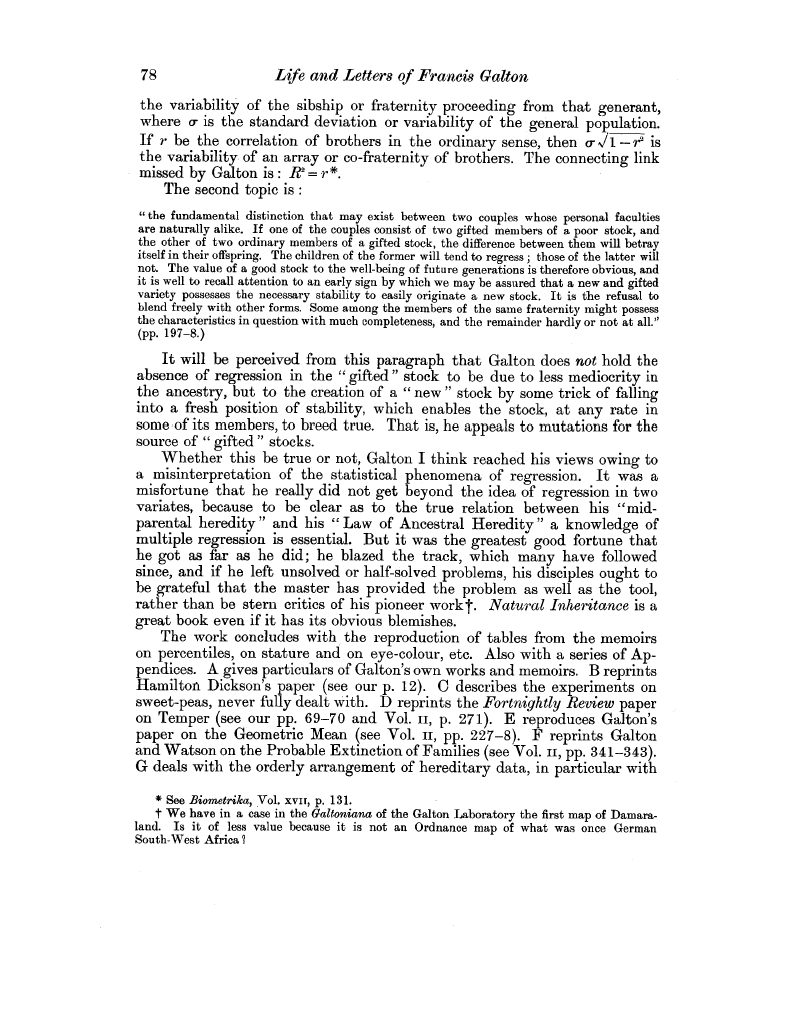| ||||||

OCR Rendition - approximate
78 Life and Letters of Francis Galton the variability of the sibship or fraternity proceeding from that generant, where a- is the standard deviation or variability of the general population. If r be the correlation of brothers in the ordinary sense, then a-%/I-r' is the variability of an array or co-fraternity of brothers. The connecting link missed by Galton is : R' = r . The second topic is "the fundamental distinction that may exist between two couples whose personal faculties are naturally alike. If one of the couples consist of two gifted members of a poor stock, and the other of two ordinary members of a gifted stock, the difference between them will betray itself in their offspring. The children of the former will tend to regress ; those of the latter will not. The value of a good stock to the well-being of future generations is therefore obvious, and it is well to recall attention to an early sign by which we may be assured that a new and gifted variety possesses the necessary stability to easily originate a new stock. It is the refusal to blend freely with other forms. Some among the members of the same fraternity might possess the characteristics in question with much completeness, and the remainder hardly or not at all." (pp. 197-8.) It will be perceived from this paragraph that Galton does not hold the absence of regression in the " gifted " stock to be due to less mediocrity in the ancestry, but to the creation of a " new " stock by some trick of falling into a fresh position of stability, which enables the stock, at any rate in some of its members, to breed true. That is, he appeals to mutations for the source of " gifted " stocks. Whether this be true or not, Galton I think reached his views owing to a misinterpretation of the statistical phenomena of regression. It was a misfortune that he really did not get beyond the idea of regression in two variates, because to be clear as to the true relation between his "midparental heredity" and his "Law of Ancestral Heredity " a knowledge of multiple regression is essential. But it was the greatest good fortune that he got as far as he did; he blazed the track, which many have followed since, and if he left unsolved or half-solved problems, his disciples ought to be grateful that the master has provided the problem as well as the tool, rather than be stern critics of his pioneer work'. Natural Inheritance is a great book even if it has its obvious blemishes. The work concludes with the reproduction of tables from the memoirs on percentiles, on stature and on eye-colour, etc. Also with a series of Appendices. A gives particulars of Galton's own works and memoirs. B reprints Hamilton Dickson's paper (see our p. 12). C describes the experiments on sweet-peas, never fully dealt with. D reprints the Fortnightly Review paper on Temper (see our pp. 69-70 and Vol. ii, p. 271). E reproduces Galton's paper on the Geometric Mean (see Vol. u, pp. 227-8). F reprints Galton and Watson on the Probable Extinction of Families (see Vol. ii, pp. 341-343). G deals with the orderly arrangement of hereditary data, in particular with * See Biometrika, Vol. xvit, p. 131. t We have in a case in the Galtoniana of the Galton Laboratory the first map of Damaraland. Is it of less value because it is not an Ordnance map of what was once German South-West Africa?
|